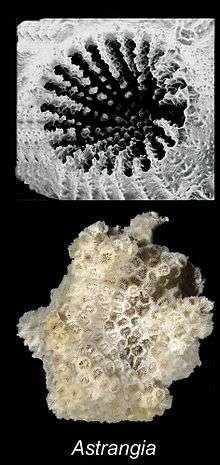Astrangia poculata
| Astrangia poculata | |
|---|---|
 | |
| Scientific classification | |
| Kingdom: | Animalia |
| Phylum: | Cnidaria |
| Class: | Anthozoa |
| Order: | Scleractinia |
| Family: | Rhizangiidae |
| Genus: | Astrangia |
| Species: | A. poculata |
| Binomial name | |
| Astrangia poculata Lamarck, 1816[2] | |
| Synonyms[2] | |
|
List
| |
Astrangia poculata, the northern star coral or northern cup coral, is a species of non-reefbuilding stony coral in the family Rhizangiidae.[3] It is native to shallow water in the western Atlantic Ocean and the Caribbean Sea. It is also found on the western coast of Africa. The International Union for Conservation of Nature lists this coral as being of "least concern".[1]
Description
Astrangia poculata grows in small clumps that are up to 5 cm (2 in) across. The individual polyps are large and sit in stony cups known as corallites. The polyps are translucent and the colony has a furry appearance when they are expanded. In warm water and with high levels of light, this coral often houses photosynthesizing symbiotic protists known as zooxanthellae in its tissues, and then the coral appears brown. In cooler, or low-light conditions, the zooxanthellae may no longer be beneficial to the coral and may be expelled, and then the coral appears pale in colour. It can be confused with the southern cup coral (Astrangia solitaria), but that species has a more southerly distribution, is generally brown, may be solitary, has larger corallites 4 mm (0.16 in) wide with 36 septa (stony ridges), [4] and does not contain zooxanthellae.[5]
Distribution and habitat
Astrangia poculata is native to the western Atlantic Ocean and Caribbean Sea where its range extends from Cape Cod in Massachusetts to the Gulf of Mexico.[6] It also occurs on the western coast of Africa. It occurs in encrusting clumps on rocks and is common under ledges and boulders, on pilings and on wrecks. It also occurs in deep water and detached clumps sometimes get washed up on shore.[1][4]
Biology
Reproduction of Astrangia poculata takes place during the summer when eggs and sperm are liberated into the water column and fertilisation takes place. The embryos hatch into planula larvae which drift with the plankton before settling to the seabed and undergoing metamorphosis into polyps.[4] Among zooxanthelate organisms, A. poculata is one of the few to have been studied with regard to the acquisition of zooxanthellae. It was found that there was no routine transfer of these symbionts from parent to offspring.[7]
The polyps spread their tentacles to feed, gathering plankton and other food particles from the water passing by. The colony grows by budding, and in favourable conditions, the clump can grow at the rate of one new polyp every three days. In colder conditions it may stop growing and the coenosarc (soft tissues) may die back to some extent [8] or lose symbionts via expulsion,[9] rendering the stony skeleton prone to being fouled by other organisms [4] and undergoing a winter quiescence.[10] The base often hosts various boring or burrowing commensal invertebrates.[11] Both temperature and symbiosis are known to influence the condition of the coral host, specifically with regards to wound-healing ability,[12][13] but it is primarily season that drives microbiome structure in Rhode Island populations of the coral.[14]
References
- 1 2 3 Aronson, R.; Bruckner, A.; Moore, J.; Precht, B.; Weil, E. (2008). "Astrangia poculata". The IUCN Red List of Threatened Species. IUCN. 2008: e.T133446A3749524. doi:10.2305/IUCN.UK.2008.RLTS.T133446A3749524.en. Retrieved 10 January 2018.
- 1 2 Cairns, Stephen (2013). "Astrangia poculata (Ellis & Solander, 1786)". World Register of Marine Species. Retrieved 2015-02-08.
- ↑ Peters, E.C., Cairns, S.D., Pilson, M.E., Wells, J.W., Jaap, W.C., Lang, J.C., Vasleski, C.E. and St Pierre Gollahon, L., 1988. Nomenclature and biology of Astrangia poculata (= A. danae,= A. astreiformis)(Cnidaria: Anthozoa).
- 1 2 3 4 Sweat, L.H. (2012-12-28). "Astrangia poculata: Northern cup coral". Smithsonian Marine Station at Fort Pierce. Retrieved 2015-02-08.
- ↑ Cairns, Stephen (2013). "Astrangia solitaria (Lesueur, 1817)". World Register of Marine Species. Retrieved 2015-02-09.
- ↑ Dimond J.L., Kerwin A.H., Rotjan R., Sharp K., Stewart F.J., Thornhill D.J. (2013). "A simple temperature-based model predicts the upper latitudinal limit of the temperate coral Astrangia poculata". Coral Reefs. 32 (2): 401–409. doi:10.1007/s00338-012-0983-z.
- ↑ Davy, Simon K.; Turner, John R. (2003). "Early Development and Acquisition of Zooxanthellae in the Temperate Symbiotic Sea Anemone Anthopleura ballii (Cocks)". The Biological Bulletin. 295 (1): 66–72. doi:10.2307/1543446.
- ↑ Dimond J., Carrington E. (2007). "Temporal variation in the symbiosis and growth of the temperate scleractinian coral Astrangia poculata". Marine Ecology Progress Series. 348: 161–172. doi:10.3354/meps07050.
- ↑ Dimond, J. and Carrington, E., 2008 Symbiosis regulation in a facultatively symbiotic temperate coral: zooxanthellae division and expulsion Coral Reefs, 27(3), pp.601-604
- ↑ Grace, S., 2017. Winter Quiescence, Growth Rate, and the Release from Competition in the Temperate Scleractinian Coral Astrangia poculata (Ellis & Solander 1786). Northeastern Naturalist, 24(sp7), pp.B119-B134.
- ↑ Jacques, T.G.; Pilson, M.E.Q. (1980). "Experimental ecology of the temperate scleractinian coral Astrangia danae I. Partition of respiration, photosynthesis and calcification between host and symbionts". Marine Biology. 60 (2–3): 167–178. doi:10.1007/BF00389160.
- ↑ DeFilippo L., Burmester E.M., Kaufman L., Rotjan R.D. (2016). "Patterns of surface lesion recovery in the Northern Star Coral, Astrangia poculata". Journal of Experimental Marine Biology and Ecology. 481: 15–24. doi:10.1016/j.jembe.2016.03.016.
- ↑ Burmester, E.M., Finnerty, J.R., Kaufman, L. and Rotjan, R.D., 2017 Temperature and symbiosis affect lesion recovery in experimentally wounded, facultatively symbiotic temperate corals Marine Ecology Progress Series, 570, pp.87-99
- ↑ Sharp K.H., Pratte Z.A., Kerwin A.H., Rotjan R.D., Stewart F.J. (2017). "Season, but not symbiont state, drives microbiome structure in the temperate coral Astrangia poculata". Microbiome. 5 (1): 120. doi:10.1186/s40168-017-0329-8.
